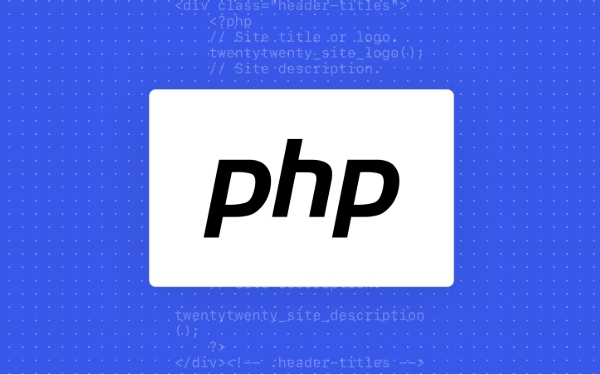 Backend Development
Backend Development
 PHP Tutorial
PHP Tutorial
 The Subtleties of Truthy and Falsy Evaluations in PHP if Statements
The Subtleties of Truthy and Falsy Evaluations in PHP if Statements
The Subtleties of Truthy and Falsy Evaluations in PHP if Statements
Jul 29, 2025 am 03:46 AMIn PHP, "0" is a falsy as a string, which will prevent the execution of if statements; in PHP, the falsy values include false, 0, 0.0, "0", "", null, empty arrays and undefined variables; 1. "00", " ", -1, non-empty arrays and objects are truthy; 2. Use empty() to safely check falsy and undefined variables but may mask spelling errors; 3. You should give priority to using ===, isset(), empty() and trim() combined with strlen() to ensure data validity and type accuracy, and avoid logical errors caused by type casting.

In PHP, understanding how values are evaluated in if statements go beyond simple boolean logic. The language uses a concept of truthy and falsy values—meaning that non-boolean values are interpreted as either true or false in a boolean context, like conditions. While this flexibility is powerful, it can also lead to subtle bugs if you're not aware of how PHP handles different data types.

Let's break down the nuances of truthy and falsy evaluations in PHP if statements.
What Counts as Falsy in PHP?
PHP has a well-defined set of values that evaluate to false in a conditional context, even if they aren't the literal false keyword. These are known as false values:

-
false -
0(integer zero) -
0.0(float zero) -
"0"(string with a single zero) -
""(empty string) -
null -
[](empty array) - The undefined variable (or a variable that has been unset)
Yes — "0" as a string is falsy. This one trips up a lot of developers.
if ("0") {
echo "This won't print!";
} Even though "0" is a non-empty string, PHP converts it to a number in a boolean context (because it looks numeric), and since that number is zero, it's considered falsy.

What Makes a Value Truthy?
Almost everything else is truthy . That includes:
-
"00"(string with two zeros) -
"false"(the string itself) -
" "(a string with just a space) - Any non-empty array (even
["", null, 0]) - Any object (even if all properties are empty)
- Resources
- The number
-1or any non-zero number (positive or negative)
Example:
if ("00") { echo "Yes"; } // Prints "Yes"
if (" ") { echo "Yes"; } // Prints "Yes"
if (-1) { echo "Yes"; } // Prints "Yes"
if ([""]) { echo "Yes"; } // Prints "Yes"Even values you might assume are "empty" can still be truthy. A space in a string is enough.
Common Pitfalls and Surprises
1. "0" vs " " vs ""
var_dump((bool)""); // false var_dump((bool)"0"); // false var_dump((bool)" "); // true
That means filtering user input like trim($input) might return " " (if the user entered spaces), which is still truthy. So always consider using empty() or trim() before checking.
2. Using empty() vs direct if
The empty() function returns true for all falsy values and for undefined variables (no warning). But be careful: empty() hides undefined variable notices.
if ($undefinedVar) { } // Triggers a notice
if (empty($undefinedVar)) { } // No notice, returns true So empty() is safe but can mask typos.
3. Type coercion in comparisons
PHP's loose comparison ( == ) interacts with truthiness in confusing ways:
var_dump("0" == false); // true
var_dump("0" == ""); // false — not the same! This is why using strict comparison ( === ) is often safe when you care about type.
Best Practices
To avoid confusion:
Use
=== trueor=== falsewhen you need exactly boolean checks:if ($value === true) { ... }This prevents any non-boolean truthy values from slipping through.
When checking for presence of data, prefer:
-
isset($var)– to check if a variable is defined and notnull -
!empty($var)– to check if it's defined and not falsesy -
strlen(trim($var)) > 0– for strings you want to be meaningfully non-empty
-
Be cautious with form inputs:
if (trim($_POST['name']) !== '') { ... }
Truthy and falsy rules in PHP are consistent once you know them, but the edge cases (like
"0"being falsy) can bite you. The key is to be explicit when the context demands it — don't rely solely on loose truthiness in critical logic.Basically: know what PHP considers empty, and when in doubt, check the type too.
The above is the detailed content of The Subtleties of Truthy and Falsy Evaluations in PHP if Statements. For more information, please follow other related articles on the PHP Chinese website!

Hot AI Tools

Undress AI Tool
Undress images for free

Undresser.AI Undress
AI-powered app for creating realistic nude photos

AI Clothes Remover
Online AI tool for removing clothes from photos.

Clothoff.io
AI clothes remover

Video Face Swap
Swap faces in any video effortlessly with our completely free AI face swap tool!

Hot Article

Hot Tools

Notepad++7.3.1
Easy-to-use and free code editor

SublimeText3 Chinese version
Chinese version, very easy to use

Zend Studio 13.0.1
Powerful PHP integrated development environment

Dreamweaver CS6
Visual web development tools

SublimeText3 Mac version
God-level code editing software (SublimeText3)
 Harnessing Short-Circuit Evaluation in PHP's Logical Operators
Jul 29, 2025 am 05:00 AM
Harnessing Short-Circuit Evaluation in PHP's Logical Operators
Jul 29, 2025 am 05:00 AM
Short circuit evaluation is an important feature of logic operators in PHP, which can improve performance and avoid errors. 1. When using &&, if the left operand is false, the right operand will no longer be evaluated; 2. When using ||, if the left operand is true, the right operand will be skipped; 3. It can be used to safely call object methods, such as if($user&&$user->hasPermission('edit')) to avoid empty object calls; 4. It can optimize performance, such as skipping expensive function calls; 5. It can provide default values, but please note that || is sensitive to falsy values, and you can use the ?? operator instead; 6. Avoid placing side effects on the right side that may be skipped to ensure that key operations are not short-circuited. just
 Improving Code Readability with Guard Clauses and Early Returns
Jul 29, 2025 am 03:55 AM
Improving Code Readability with Guard Clauses and Early Returns
Jul 29, 2025 am 03:55 AM
Using guard clauses and early return can significantly improve code readability and maintainability. 1. The guard clause is a conditional judgment to check invalid input or boundary conditions at the beginning of the function, and quickly exit through early return. 2. They reduce nesting levels, flatten and linearize the code, and avoid the "pyramid bad luck". 3. Advantages include: reducing nesting depth, expressing intentions clearly, reducing else branches, and facilitating testing. 4. Commonly used in scenarios such as input verification, null value check, permission control, and empty collection processing. 5. The best practice is to arrange the checks in order from basic to specific, focusing on the function start part. 6. Avoid overuse in long functions causing process confusion or causing resource leakage in languages that require resource cleaning. 7. The core principle is: check as soon as possible and return as soon as possible
 Mastering Strict vs. Loose Comparisons in PHP Conditionals
Jul 29, 2025 am 03:05 AM
Mastering Strict vs. Loose Comparisons in PHP Conditionals
Jul 29, 2025 am 03:05 AM
Using == for strict comparison will check the value and type at the same time, and == will perform type conversion before comparing the value; therefore 0=='hello' is true (because 'hello' is converted to an integer is 0), but 0==='hello' is false (different types); common traps include '0'==false, 1=='1abc', null==0 and []==false are all true; it is recommended to use === by default, especially when processing function return value (such as strpos), input verification (such as the third parameter of in_array is true), and state judgment to avoid unexpected results caused by type conversion; == is only used when it is clearly necessary to use ==, otherwise
 Refactoring the Pyramid of Doom: Strategies for Cleaner PHP if Blocks
Jul 29, 2025 am 04:54 AM
Refactoring the Pyramid of Doom: Strategies for Cleaner PHP if Blocks
Jul 29, 2025 am 04:54 AM
Useearlyreturnstohandlepreconditionsandeliminatedeepnestingbyexitingfastonfailurecases.2.Validateallconditionsupfrontusingadedicatedhelpermethodtokeepthemainlogiccleanandtestable.3.Centralizevalidationwithexceptionsandtry/catchblockstomaintainaflat,l
 Implementing Dynamic Feature Flags with Elegant Conditional Logic
Jul 29, 2025 am 03:44 AM
Implementing Dynamic Feature Flags with Elegant Conditional Logic
Jul 29, 2025 am 03:44 AM
Maintainable implementations of dynamic functional flags rely on structured, reusable, and context-aware logic. 1. Structural definition of function flags as first-class citizens, centrally manage and accompany metadata and activation conditions; 2. Dynamic evaluation is performed based on runtime context (such as user roles, environments, grayscale ratios) to improve flexibility; 3. Abstract reusable condition judgment functions, such as roles, environments, tenant matching and grayscale release, avoiding duplicate logic; 4. Optionally load flag configurations from external storage, supporting no restart changes; 5. Decouple flag checks from business logic through encapsulation or hooks to keep the code clear. Ultimately achieve the goals of secure release, clear code, fast experimentation and flexible runtime control.
 Secure by Design: Using if Statements for Robust Input Validation
Jul 30, 2025 am 05:40 AM
Secure by Design: Using if Statements for Robust Input Validation
Jul 30, 2025 am 05:40 AM
InputvalidationusingifstatementsisafundamentalpracticeinSecurebyDesignsoftwaredevelopment.2.Validatingearlyandoftenwithifstatementsrejectsuntrustedormalformeddataatentrypoints,reducingattacksurfaceandpreventinginjectionattacks,bufferoverflows,andunau
 Performance Deep Dive: if-elseif-else vs. switch in Modern PHP
Jul 29, 2025 am 03:01 AM
Performance Deep Dive: if-elseif-else vs. switch in Modern PHP
Jul 29, 2025 am 03:01 AM
Switch is usually faster than if-elseif-else, especially when there are more than 5 discrete values and PHP can be optimized to skip tables; 2. If-elseif is more suitable for complex or range condition judgments; 3. The performance of the two is similar when a small number of conditions (1–3); 4. Turn on Opcache to improve the optimization opportunities of switches; 5. Code readability is preferred, and it is recommended to use PHP8.0 match expressions in simple mapping scenarios because they are simpler and have better performance.
 Crafting Complex Conditional Logic with &&, ||, and Operator Precedence
Jul 30, 2025 am 04:48 AM
Crafting Complex Conditional Logic with &&, ||, and Operator Precedence
Jul 30, 2025 am 04:48 AM
When using && and || to build complex conditions, operator priority and short-circuit behavior must be clarified; 1.&& priority is higher than ||, so a||b&&c is equivalent to a||(b&&c); 2. Use brackets to clarify logical groups. If you need to "login or have permission and are not visitor", you should write it as (loggedIn||hasPermission)&&!isGuest; 3. Split complex conditions into descriptive variables to improve readability; 4. Test boundary conditions to avoid relying on intuitive judgment; ultimately, clarity should be used as the goal to ensure that the code logic is easy to understand and maintain.





